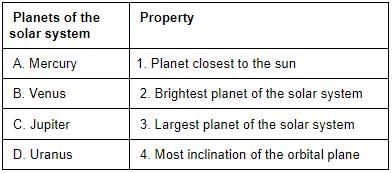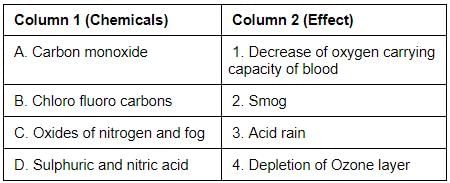Test: Class 8 General Science NCERT Based - 4 - UPSC MCQ
30 Questions MCQ Test Science & Technology for UPSC CSE - Test: Class 8 General Science NCERT Based - 4
Consider the following statements about friction.
1. Heat is generated due to friction.
2. Kabaddi players rub dust on their hands, so that friction is increased when they try to grab their opponents.
3. Friction applied by fluids is called drag.
4. Sliding friction is less than static friction.
Which of the statements given above is/are correct?
Consider the following statements with respect to sound:
1. It can travel through solids, liquids, gases and vacuum.
2. The intensity of sound is measured in decibels (dB).
3. For the human ear, the range of audible frequencies is roughly from 20 Hz to 20,000 Hz.
Which of the statements given above is/are correct?
Consider the following statements regarding pitch of sound.
1. It depends on the frequency of sound.
2. Birds produce high pitched sound; while the roar of a lion is a low pitched sound.
3. Generally, females have a higher pitched voice than males.
Which of the statements given above is/are correct?
Assertion A: Utensils used to store food have a layer of tin electroplated over iron.
Reasoning R: Tin is less reactive than iron.
Choose the correct answer from the options given below:
Assertion A: Iron used to strengthen the bridges and automated vehicles, has a tendency to be easily corroded and rusting.
Reasoning R: To prevent the corrosion and rusting, a layer of zinc is electroplated on iron.
Select the correct answer from the options given below:
Which of the following is/ are correct definition of types of friction?
1. Dry friction resists relative lateral motion of two solid surfaces in contact.
2. Fluid friction describes the friction between layers of a viscous fluid that are moving relative to each other.
Which is/are correct statement (s)?
Which of the following is/ are not applications of Ultrasonic Waves?
1. For measuring the depth of the Sea.
2. In sterilizing of a liquid.
3. In Ultrasonography
4. In sterilizing a needle.
Options are:
What will be the effect of temperature on speed of sound?
A positive charge is moving towards a person. The direction of magnetic field lines will be in
Which of the following statements is not correct?
Consider the following statements regarding lightning:
1. Positive charge accumulated near the surface of the earth and the negative charge accumulated at the lower surface of the clouds combine to generate light and sound of lightning.
2. The process of generation of lightning is called electric discharge. This can occur between two or more clouds; or between the clouds and earth.
3. To protect the buildings from lightning, an object called a lightning conductor is used.
Which of the statements given above is/are correct?
The earth is divided into many layers. Which of the following layers is responsible for tremors?
Consider the following statements about earthquakes:
1. Earthquakes are caused by the movement of plates, the boundaries of the plates are the weak zones where earthquakes are more likely to occur. The weak zones are also known as seismic or fault zones.
2. In India, the areas most threatened are Kashmir, Western and Central Himalayas, the whole of North-East, Rann of Kutch, Rajasthan and the Indo – Gangetic Plain. Some areas of South India also fall in the danger zone.
Which of the statements given above is/are correct?
Consider the following statements regarding the measurement of the magnitude of the earthquake.
1. The power of an earthquake is expressed in terms of a magnitude on a scale called Richter scale.
2. Richter scale is a linear scale.
3. An increase of 2 in magnitude means 1000 times more destructive energy.
Which of the statements given above is/are correct?
Consider the following statements:
1. Emission of light by objects.
2. Reflection of light by objects.
3. Dispersion of light.
Which of the above is/are related to the phenomenon of seeing objects?
Which of the following parts of the eye is responsible for its characteristic color?
Consider the following statements about retina:
1. Retina contains several nerve cells.
2. The blind spot is present at the junction of the optic nerve and the retina.
3. The impression of an image does not vanish immediately from the retina.
Which of the statements given above is/are correct?
Which of the following is the Braille system associated with?
Animals have eyes shaped in different ways, and have various specialities. Consider the following statements regarding these specialities:
1. Eyes of a crab are quite small but they enable the crab to look all around him.
2. Butterflies have large eyes that seem to be made up of thousands of little eyes.
3. The Owl has a large cornea and a large pupil to allow more light in its eye.
Which of the statements given above is/are correct?
Consider the following statements regarding the moon.
1. The moon completes one rotation on its axis as it completes one revolution around the Earth.
2. The day on which the whole disc of the moon is visible is known as the full moon day. The time period between two consecutive full moons is a little less than 29 days.
3. Neil Armstrong landed on the moon for the first time followed by Edwin Aldrin.
Which of the statements given above is/are correct?
Consider the following statements regarding the stars.
1. The stars rise from the east after sunset, and set in the west just before sunrise.
2. The distance between stars is expressed in light years.
Which of the statements given above is/are correct?
The stars forming a group that has a recognisable shape is called a constellation. Consider the following statements regarding constellations:
1. One of the most famous constellations is Ursa Major, also known as ‘Saptarishi’.
2. Orion is also called The Hunter.
3. Cassiopeia looks like distorted W or M.
Which of the statements given above is/are correct?
Match the items of column 1 with column 2 and use the code given below to choose the correct


Consider the following pairs:
1. Earth: Blue
2. Mars: Red
3. Saturn: Yellow
Which of the pairs given above is/are correctly matched with respect to the planets and their colours?
Consider the following statements regarding asteroids, comets and meteors.
1. Asteroids are present between Mars and Jupiter.
2. Comets revolve around the sun in elliptical orbits.
3. Meteors are called shooting stars.
Which of the statements given above is/are correct?
Match the items of column 1 with column 2, using the code given below.


Consider the following gases:
1. Carbon Dioxide
2. Nitrous Oxide
3. Methane
4. Water vapour
Which of the above is/are greenhouse gas/gases?
Consider the following statements:
1. The chemical process of the purification of drinking water is called chlorination.
2. To protect the Ganges from pollution, Ganga Action Plan was started in the year 1985.
Which of the statements given above is/are correct?
Consider the following statements regarding water pollution:
1. Pesticides and weedicides, used to protect the crop pollute the groundwater.
2. Hot water from factories and power plants are also water pollutants.
Which of the statements given above is/are correct?
|
114 videos|430 docs|209 tests
|




















